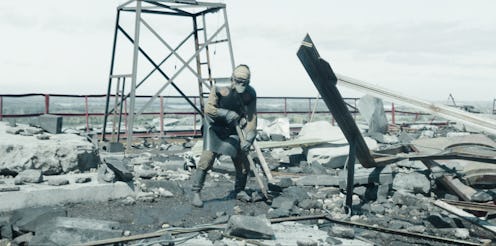Entertainment
You'll Never Complain About Your Job Again After Watching The 'Chernobyl' Clean Up Crew

Spoilers ahead through Chernobyl Episode 4. Even for audiences who already knew what happened at the Ukrainian Chernobyl power plant back in 1986, the HBO series is still shocking. After the reactor exploded, so did the core, and the radiation levels reached a staggering 15,000 roentgen. So after the government had the nearby residents of Pripyat evacuated, the Chernobyl liquidators were able to perform a sizable task of both cleaning up and preventing this tragedy from recurring.
And audiences saw first-hand what happened to those exposed to the radiation in Episode 3, with Vasily Ignatenko's final days. As Valery Legasov (Jared Harris) explained in the same episode, dying of radiation poisoning is a brutal way to die. "Ionizing radiation tears the cellular structure apart," he told Boris Shcherbina (Stellan Skarsgård). "The skin blisters, turns red, then black."
And after a short latency period, he said, "the cellular damage begins to manifest. The bone marrow dies, the immune system fails, the organs and soft tissue begin to decompose. The arteries and veins spill open like sieves, to the point where you can't even administer morphine for the pain, which is unimaginable. And then three days to three weeks, you are dead."
And while they were essentially sending men to their graves, the death toll would have been that much higher if they'd done nothing. Hence the liquidators, who were the crew responsible for cleaning up the sizable mess left at Chernobyl. According to Wired, 600,000 liquidators were recruited, which consisted of firefighters, miners, soldiers, and even janitors.
But since these levels of radiation were so lethal, they first planned to perform the worst of the cleanup with robots. "That is the most important thing, general," Valery says at the beginning of Episode 4. "Under no circumstances can men go up there [on the roof]. Robots only." That said, it seems like men had to perform many of these tasks after all, according to the National Geographic, which published photos of some liquidators attaching lead aprons to their torsos to prevent radiation exposure to their vital organs.
National Geographic reported that those who received the highest doses were on the roof of the power plant (where Valery had claimed men would never go). And while robots first began cleaning up the contamination on the roof, they soon stopped working. As a result, men had to take over, who became known as "biorobots," per the article, and would stay on the roof for just a few minutes at a time, shoveling a small amount of the material before another group of liquidators would take their place.
According to the International Atomic Energy Agency, the projects these men worked on varied and included building towns and housing for plant workers, dams, waste repositories, and water filtration systems. Furthermore, there was also the "sarcophagus" — a structure which surrounded the fourth reactor in order to prevent further radiation from spreading. The sarcophagus structure stayed in place until it was replaced in 2016, per the Radio Free Europe/Radio Liberty, and is now referred to as the New Safe Confinement (NSC).
"The liquidators were sent into impossible scenarios where even machines failed," photographer Tom Skipp, who photographed some of Chernobyl's survivors, told Wired. "Each has a human story seemingly entangled in the complex history of communism and duty to the motherland." The magazine reported that these individuals were exposed to 120 millisieverts of radiation, which is like getting an x-Ray 1,200 times. As a result, over 4,000 of these liquidators died from cancer, per the article, and another 70,000 were disabled.
Chernobyl was a terrible tragedy with an unparalleled effect on its surroundings. And while the death toll was astronomically high, it's thanks to the plant's liquidators that the fallout wasn't even bigger than it was.